How to Conduct a Force Field Analysis (Free Tool & Template)
When making business decisions, you’ll always run into promoters and detractors for new change projects.
But organizational change is inevitable and necessary for business – and having a plan to quickly make and implement business decisions is critical to organizational success.
To drive successful adoption of new initiatives or processes, change agents use popular change management exercises such as a force field analysis to identify roadblocks and pillars of support – and overall shorten the time from business ideation, decision, and implementation.
What is Force Field Analysis?
The force field analysis is a widely used change management and business-diagnostic tool to help organizations gain perspective on the forces at play when you’re trying to make a large business change or decision. This approach was conceived by German-American psychologist Kurt Lewin, the creator of Lewin’s 3-Stage Model of Change, and who is also credited as the founder of modern psychology.
Lewin’s Force-Field Theory states that two sets of forces — called the driving and restraining forces — are always in opposition in an organization. When they’re in equilibrium, you maintain the status quo.
To drive change, you must strengthen the driving forces, weaken restraining forces, or do both simultaneously.
Similar to Newton’s first law of motion, a body remains in a state of inertia unless acted upon by an external force. The same is true for organizations. Orchestrating business change requires external forces, and conducting a force field analysis enables that process.
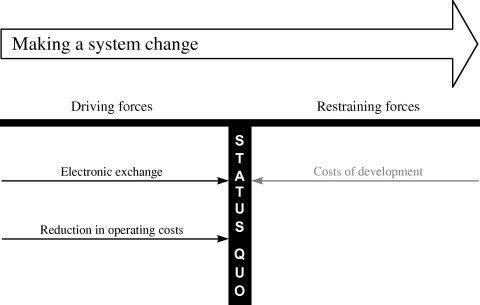
When Should You Use Force Field Analysis?
While the force field analysis is used to diagnose a problem, you can use it to:
- Recognize the balance of power
- Identify decision-makers
- Learn who the biggest cheerleads and critics are
- Find ways to influence those against change
- Decide whether you should go ahead with a proposed change
- Help determine the right business decision
How to Conduct a Force Field Analysis
Using this change management tool allows you to visually map the forces for, and against, a change proposal in the workplace or help decide on a difficult business decision.
Here are a few examples of what a force field analysis chart will look like:
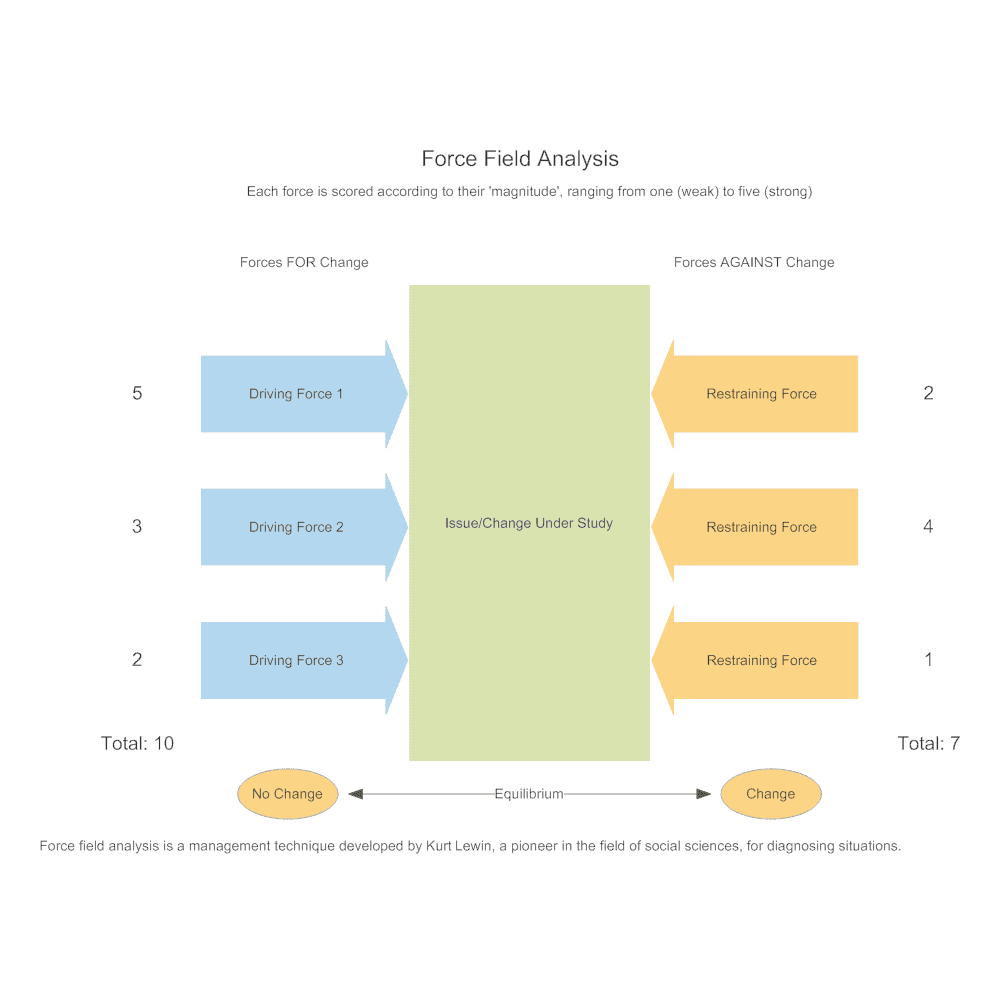
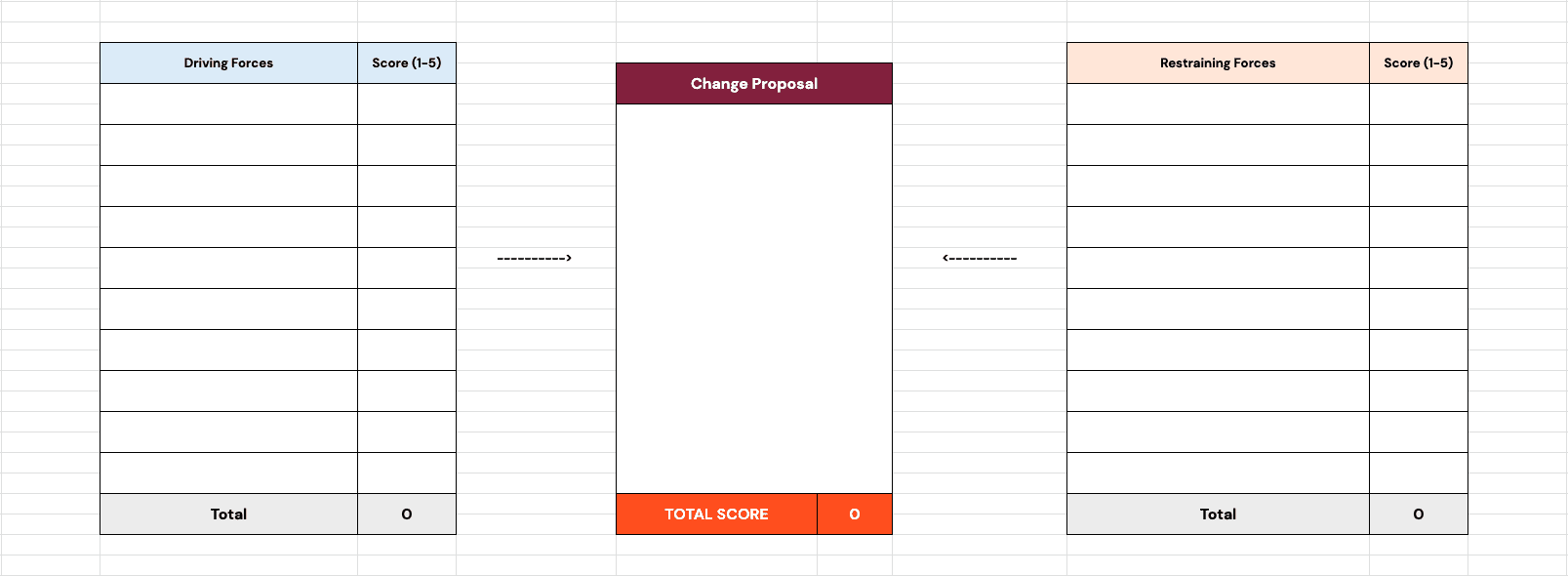
Download this force field analysis chart template seen above, for free, here!
Here are the six steps to help you complete a force field analysis to help you come to a business decision:
1. Define the objective of your change project
Perhaps you’re trying to implement new software, going through a merger, or have a change in leadership. The first step to effective change management in all cases is defining the expected outcomes.
What do you hope will happen if the organization goes through the proposed change? Write that down in the middle of your force field analysis template.
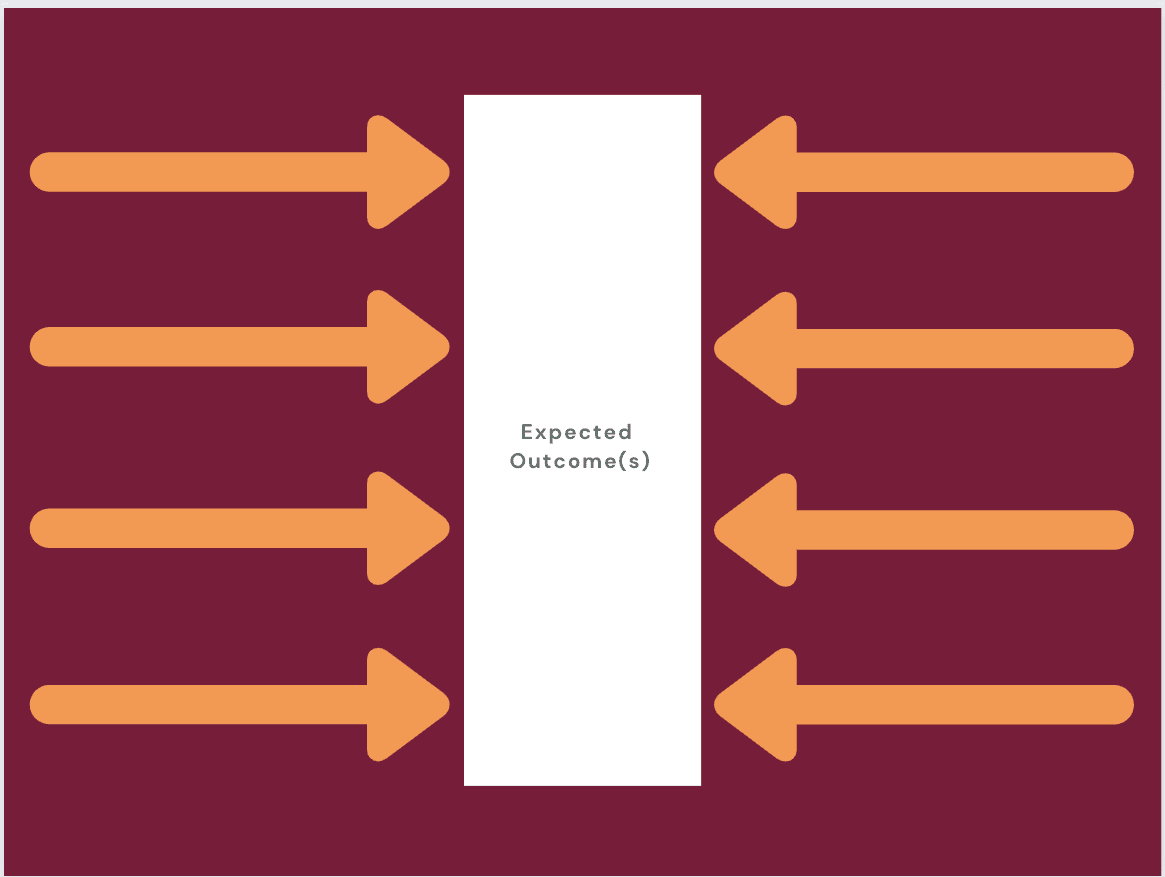
2. Identify and list all driving forces for the change
Driving forces are the factors that will support the expected outcomes you desire. In Lewin’s model, these are considered a positive influence and can be internal or external.
Internal driving forces of change might include:
- Outdated product lines
- Old machinery
- Diminishing employee morale
- Declining profitability
While external driving forces could include:
- Rapidly changing industry
- Disruptive technologies
- Increased competition
- Changing demographic trends
Think about as many driving forces as you can that would help you affect change and list them down on the left side of your template.
You can turn to your internal team or consult change agents specializing in organizational change management.
Use some of these questions to help you arrive at the answers:
- Who supports organizational change? Who may be against it?
- Do you have the necessary resources to bring change?
- What are the costs and risks involved?
- Which processes will be impacted by the change?
3. Identify and list forces pushing against the change
Forces against the change, or restraining forces, are factors that will resist the change and make it harder for you to attain your desired outcome. Similar to driving forces, restraining forces can be internal or external.
| Internal forces against the change might include: |
|
| External restraining forces could include: |
|
Write as many forces you can think of down on the right side of your force field analysis chart.
At the end of this step, your force field analysis should look something like this:
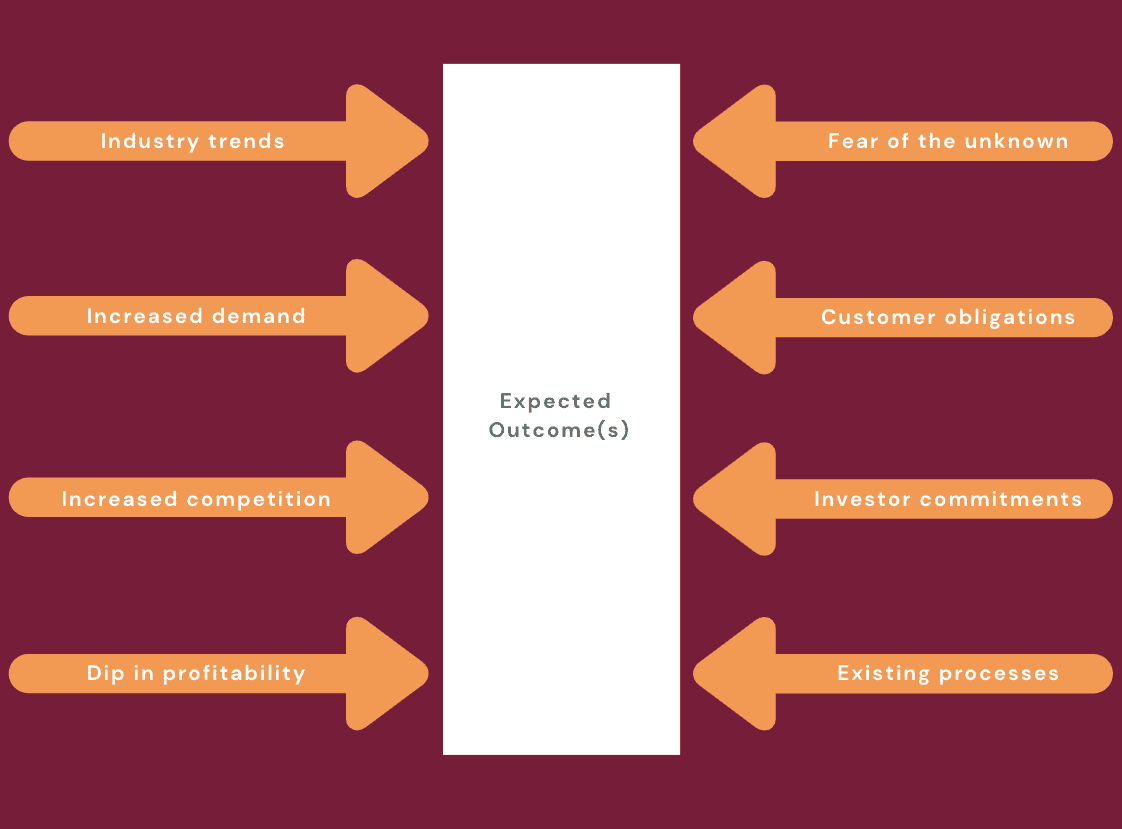
4. Assign each force an impact score
Each force has a varying degree of influence on the expected outcome. To accommodate this, score each individual restaining and driving force a score from one(weakest) to five(strongest) to showcase which forces have the most impact.
You may also rate forces on a scale of 1-10, and choose to leave out forces that are too weak.
Using Whatfix’s force field template, write down each force and the score next to it, and add it all up.
Below is an example of what this will look like:
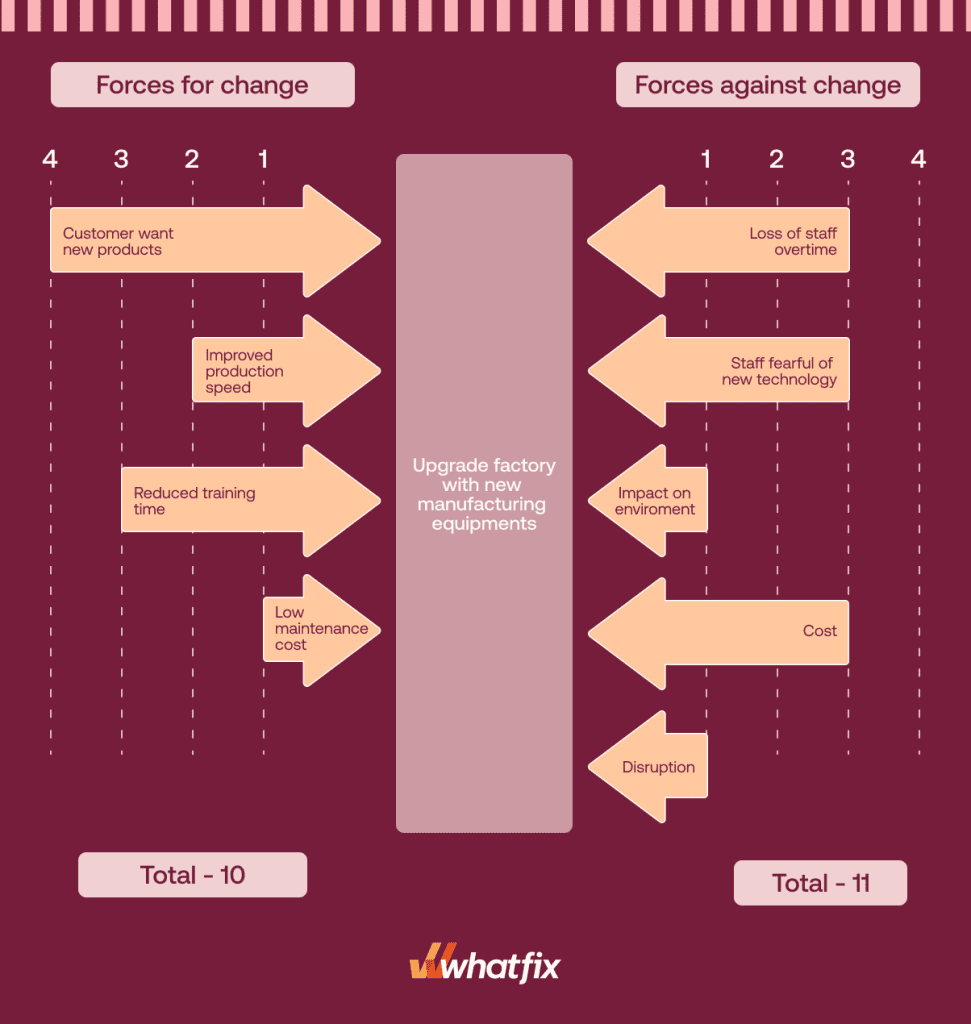
5. Propose solutions to positive influence the forces
Effective organizational change comes down to making your driving forces stronger, and eliminating or weakening the restraining forces pushing against a change.
Based on your evaluation, you can identify which forces may be weakened and which you can strengthen.
For instance, in the example above, you could:
- Train staff to minimize the fear new technology adoption
- Invest in better L&D tools to reduce training time
- Buy new machinery to make your maintenance costs even lower
- Make sure the new machinery is sustainable to reduce your environmental impact
These solutions help swing the balance in your favor and make change implementations and transitions smooth.
6. Create a Change Management Plan
If your proposed solutions cannot help you meet your goals, you may have to rethink your strategy.
But if your approach is viable, formalize your solutions in the form of a change management plan.
Your plan should include:
- The well-defined objectives of the change project
- Space for feedback from all stakeholders
- Learning & development training sessions
- All the action steps you need to take
- Who’s responsible for each action step
- Timeline for each part of the plan
- Milestones you need to hit
- Resources at your disposal and ones you need
7. Leverage a proven change management model
Change management models are frameworks with specific guidelines that help you plan and implement the change project. Learning these models can help you adopt best practices, so your organizational change is successful.
You can use one, two, or a combination of these proven change management models that have been tested by other businesses and developed by experts.
- Lewin’s Change Management Model
- McKinsey 7-S Model
- Nudge Theory
- The ADKAR Change Management Model
- Kübler-Ross Change Curve
- Bridges’ Transition Model
- Satir Change Model
- Kotter’s 8-Step Theory
- Maurer 3 Levels of Resistance and Change Model
- Deming Cycle (PDCA)
While the specifics may differ, all these change management models have one thing in common; they’re employee-centric.
Centering your plans around your employees can have a substantial positive impact on the success of your change project. Consider their reaction and feedback to make them a part of the process. Give them a sense of ownership rather than treating them as bystanders.
Note: There is no best change management model because each business has unique needs. By taking the time to understand them all, you can determine which makes sense for you or take elements of each to create your own plan.
✓ Thank you, the template will be sent to your email
Mini Case Study: How Netflix Changes its Business Model to Survive
Netflix is a prime example of successful organizational change that used Lewin’s change management model to do so.
Founded in 1997, Netflix sold DVDs and rentals by mail with a pay-per-rental model. In 1999, they launched a subscription service that allowed customers to rent unlimited DVDs for a fixed monthly price without late fees.
The pay-per-rental was transformed into a pay-for-use model.
But by 2007, interest in DVDs began to falter. 2 years of declining sales later, the market for DVDs had shrunk by 4.5% in 2007. Although Netflix’s sales were growing, Netflix’s CEO, Reed Hastings, knew they had to future-proof the business.
That was the second significant change. They went all-in on video streaming rather than focusing on improving the quality of physical delivery and managing the logistics.
But the problem was the technology to support this plan didn’t quite exist, so Netflix took a risk and launched its streaming service called “Watch Now.”
No one else was investing the kind of time, energy, and capital into building a comparable product, so by the time everyone caught on, Netflix had become the best streaming service.
So while there was no customer demand (driving force), a lack of tech advancement (restraining force), Netflix bet big on streaming, and it paid off.
Cut to now, and Netflix has rolled out several changes to satisfy its users:
- 2011: Launched mobile apps for both Android and iOS
- 2016: Rolled out the offline playback feature
- 2018: Introduced the “Skip Intro” button
- 2022: Unfurled its plans to extend into video gaming
You can see how the above changes help to reinforce the positive force field influencers and reduce the negative impact of those pushing against the company’s change.
Change models Netflix used for pricing
In reality, all the steps of change models cannot be implemented nor put in practice as stipulated by the theories as you’ll soon see.
Change agents may skip some steps, so it is pretty difficult to isolate all the different models, but here’s a sample of all the change models at play when Netflix changed its pricing tiers.
| Lewin’s Change Model | Netflix struggled to introduce pricing plans that factor in the cost of internet and licensing fees. This is where they adopted strategies that envisaged Lewin’s 3 step change model based on his force field theory—Unfreeze, Change, and Refreeze. Customers were unhappy with a single-price plan since all customers have different needs but they were not being met. Netflix announced changing pricing plans to include more options (Unfreeze), and went through the change (Change). But since they are still experimenting with pricing, they haven’t returned to normalcy (Refreeze). |
| Kotter’s 8-Step Model | In regards to Kotter’s model, Hastings completed the first step—to convince customers about making these changes. Hastings also included his co-founders, showing a strong coalition in the making. He then built a strong vision with the help of the team, completing the third step of the model. Finally, they communicated their vision to customers and investors, completing the fourth stage of the model. |
Don’t allow user adoption to become a negative force on your change projects
Change management has been around for decades. But even the best, well-intentioned change projects fail. In fact, the data for change project failure rate has stood at 70% for a long time.
But according to consulting firm BCG, we’ve gotten worse at it. “75% of transformation efforts don’t deliver the hoped-for results.”
Of all the reasons that your change project could go wrong, don’t allow user adoption to be one of them. One of the most crucial aspects of change management, getting employees to accept and commit to these changes, can only come when you invest in training and perhaps re-training.
But employee learning cannot be siloed. Expecting them to go through major changes while accomplishing what’s already on their plate is a recipe for disaster.
Digital adoption platforms such as Whatfix can help you fix that. With Whatfix, you can get the support you need to help your implementation succeed. Employees receive support in the form of in-app content and access to training resources, helpful tips, product tours, interactive tours without ever having to leave the platform.
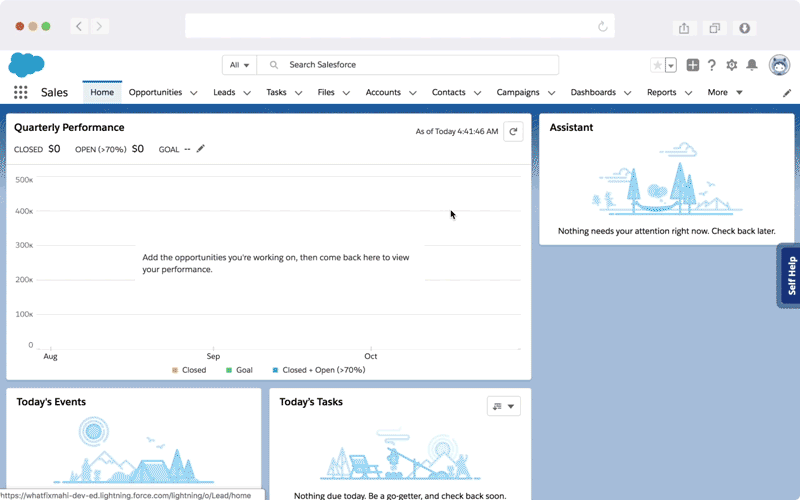
The help employees receive is context-aware and personalized with the ability to be delivered in a format that they’re most receptive to—video, PDF, or task lists. So adoption can occur at their pace, and your change project is more likely to succeed.
Force Field Analysis
FAQs
1. What are alternatives to the force field analysis?
You can use a range of decision making tools to either complement or replace the force field analysis such as the cost/benefit matrix, scenario analysis, SWOT, or Pareto analysis.
2. What are the advantages of the force field analysis?
Some of the advantages of using the Force Field Analysis are:
- It’s easy to understand
- It shows the risk change carries visually
- Helps with decision making
- Can involve everyone in the process
3. What are the limitations of the force field analysis?
Like with any theory, force field analysis has a few disadvantages:
- The scoring is subjective
- Development takes time
- It cannot be used to analyze overly complicated situations
Request a demo to see how Whatfix empowers organizations to improve end-user adoption and provide on-demand customer support
Thank you for subscribing!
Thank you for subscribing!


